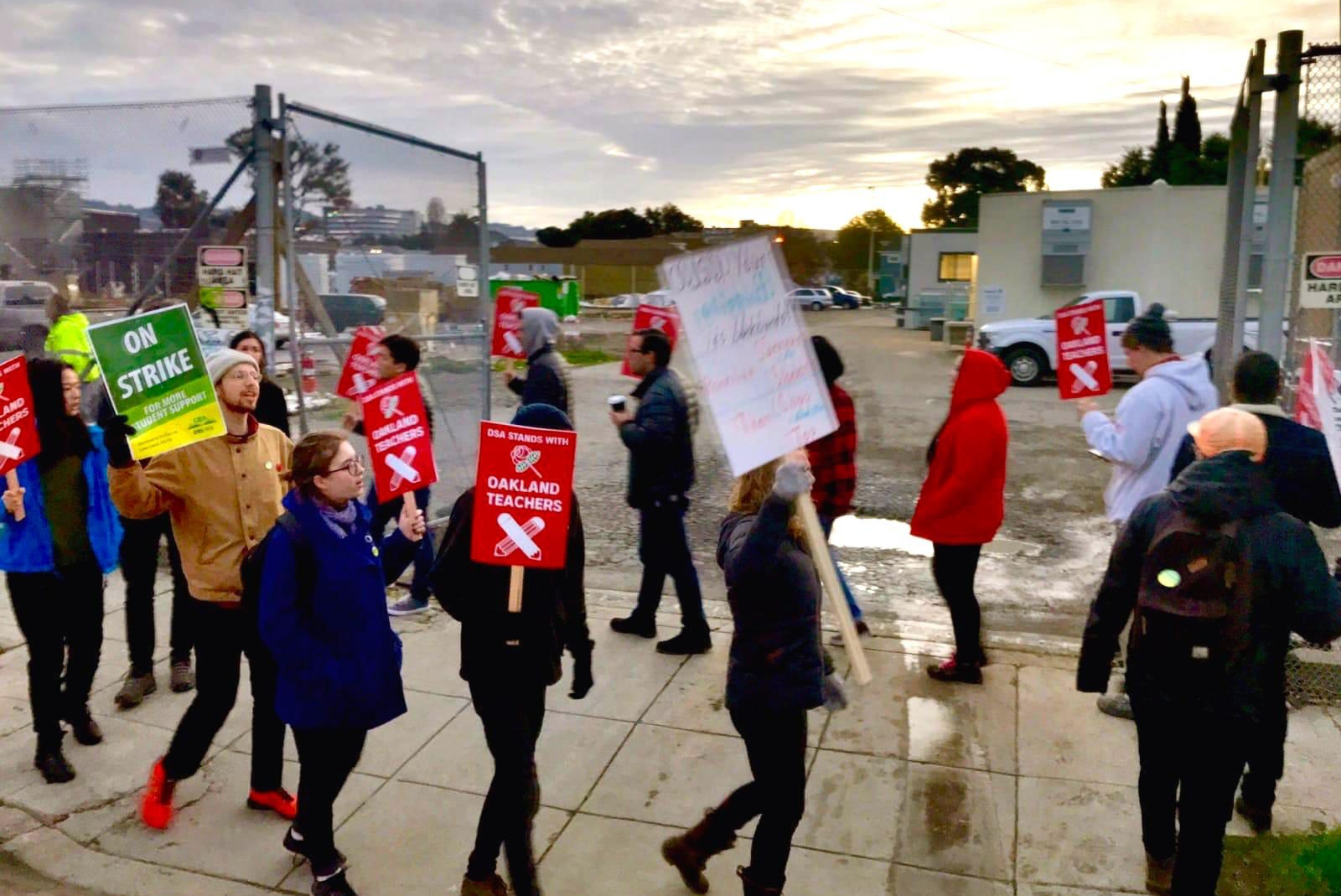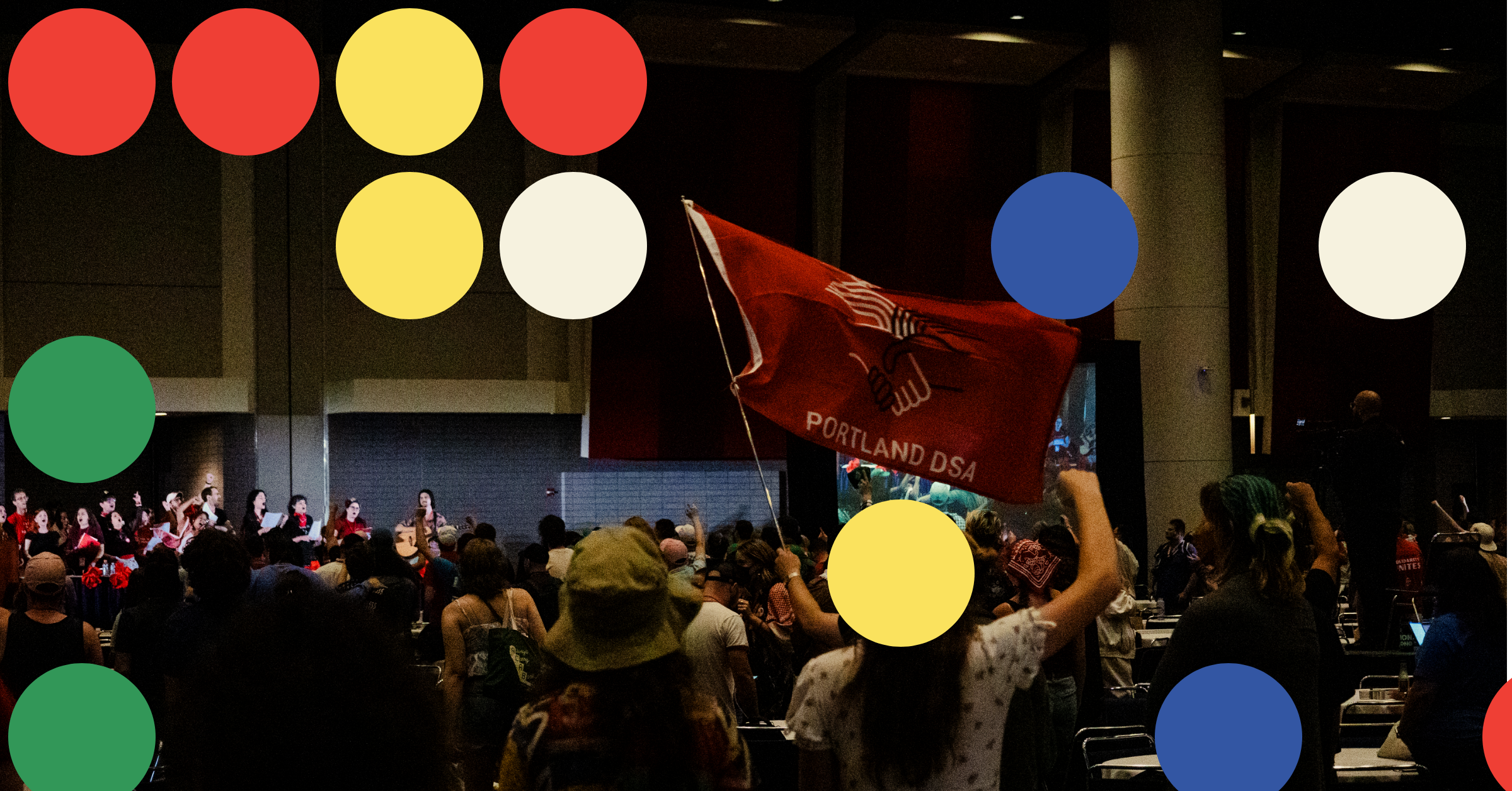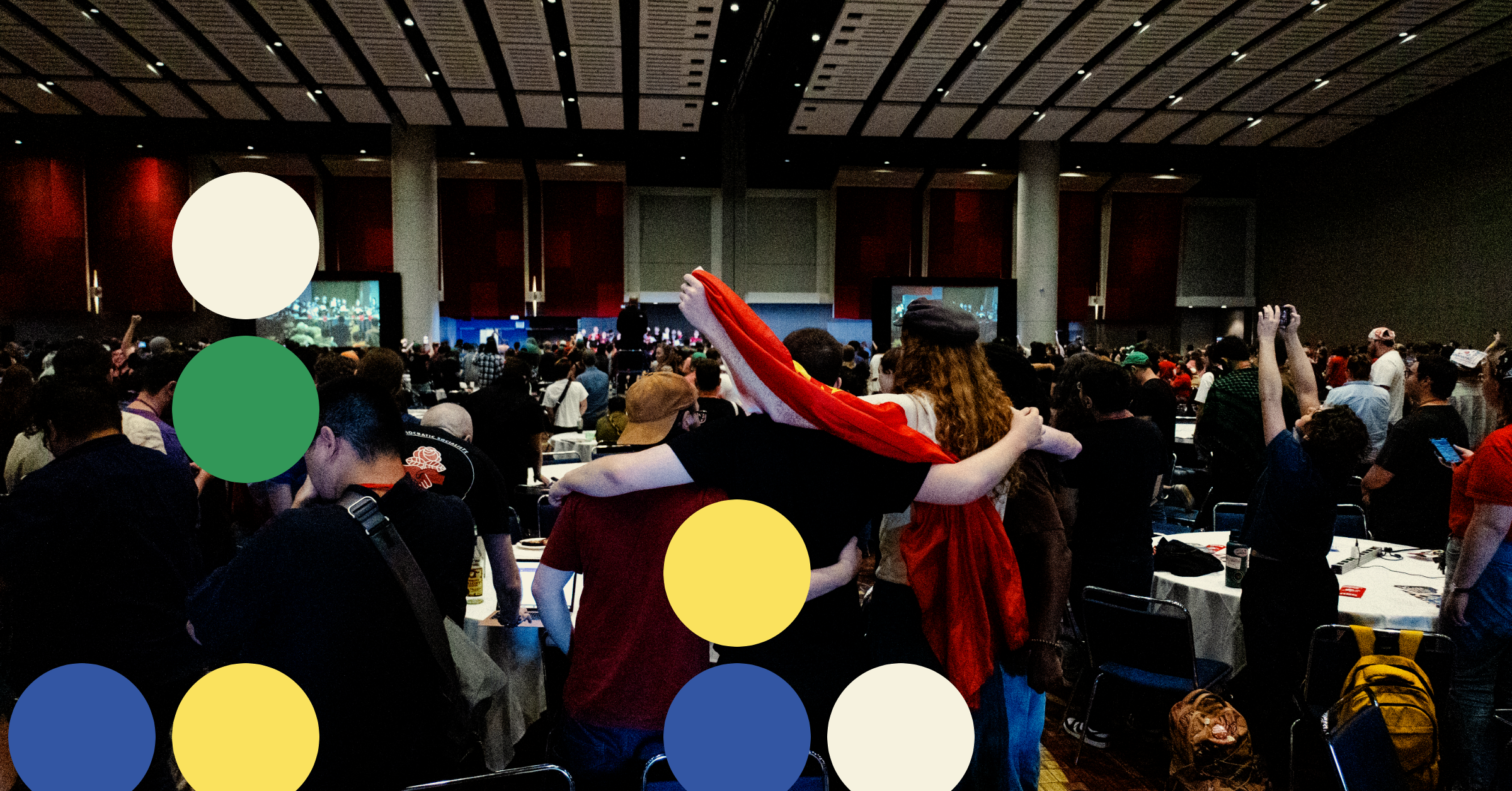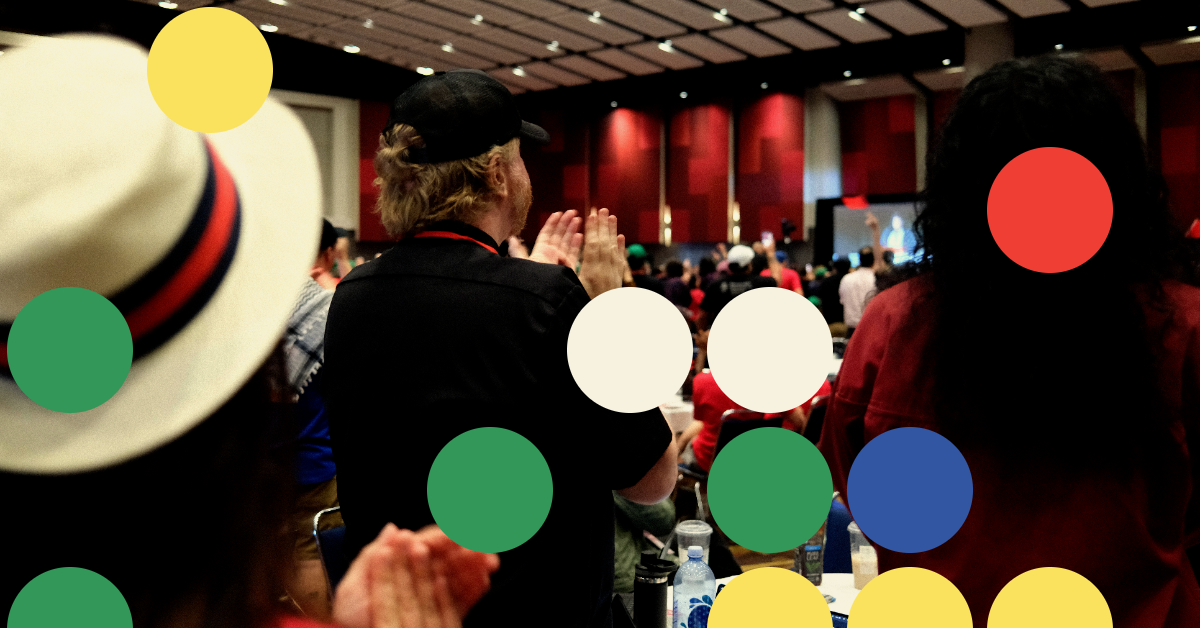DSA has made huge strides in just three years. Chapters in all 50 states have developed nearly as many models of organizing. Starting on the humble foundations of the long-marginalized American left, we need to share and refine those organizing models that can help DSA chapters become catalyzing centers in a working-class movement.
With that in mind, we — as two leaders on our chapter Steering Committee this past year and candidates for co-chair for next year — want to share what we believe have been the successes and lessons learned in East Bay DSA so far. We hope that comrades in other chapters will find our experiences useful, just as we have learned a great deal from the work being done in DSA chapters and in social movements across the country.
Our context has been unique in some ways, as a large chapter and one of only a few with a majority in elected leadership from the Bread & Roses caucus (and to be clear, our chapter’s achievements in the last year came through the united effort of members all across the chapter). We definitely don’t believe our caucus or our chapter has all the answers. And we’ve learned the most by facing our work outwards, taking guidance from militant and newly organizing workers. But we think we’re starting to build an organizing model that helps us learn the answers we need, and we’re excited to share it as a contribution to ongoing debates about what should come next for DSA.
Jovanka Beckles and the Prop 10 Campaign
When our chapter committed to electing Richmond Progressive Alliance leader and DSA member Jovanka Beckles to the State Assembly, and to pass Proposition 10 to end state limits on rent control, we knew we’d never taken on work with such huge scale or immediate stakes. Our chapter had grown from a small core of activists in early 2016 to over 1,100 members by late 2017, with about 150 members regularly active in our political education, Medicare for All canvassing, and organizer training programs.
Over the course of two dedicated meetings in October 2017, we discussed whether and how to campaign for Jovanka. We clarified how electoral work should fit into the larger socialist strategy of unifying and organizing in the working class and how to support Jovanka — who was running tactically on the Democratic ballot line — while being clear that we had no intentions as DSA of trying to take over the hopelessly corrupt infrastructure of the Democratic Party. Over 75% of our membership voted for the campaign. And in February 2018, with nearly unanimous support, we decided to jump into the fight for Prop 10. We were off to war with the most powerful elites in California.
These chapter-wide discussions led to the most unified mass action we’d undertaken yet. In the last month before Jovanka’s crowded primary on June 5, we sprang into action, with 60 members canvassing over 8,000 doors and rallying in parks and transit stations. Jovanka made it through the primary by a margin of 300 votes. We were elated to have helped get the win, but we knew we needed to get bigger and better to have a serious shot at the general.
Over the summer, we brought together leaders from all our campaign committees into a joint super committee. Our July membership meeting voted overwhelmingly to set the Jovanka and Prop 10 campaigns as top priorities for the election. Jovanka asked for our help crafting a visionary democratic socialist platform. We built a propaganda team that contrasted Jovanka’s transformative policies and working-class movement to the billionaire donors funding her neoliberal opponent. We helped with design and videos, viewed by hundreds of thousands of people. Our organizers built the field operation for Jovanka in the southern half of the district and expanded our canvassing into three new diverse working class areas.
By general election day, our electoral actions had turned out 130 members, alongside 215 non-members (largely union members), canvassed over 18,000 doors, and reached over 100,000 more through videos. Based on past elections, we targeted 80,000 votes as the number needed to win. Jovanka ultimately won over 90,000 votes. But amid an overall turnout surge, and outspent more than 10:1 by billionaire cash for her opponent’s smear campaigns, we ultimately came up short at 46%. The statewide Prop 10 campaign, fighting $76 million of real estate opposition spending, came up shorter still — but we were proud to see we’d helped the largest county in our chapter’s turf become one of a very few where rent control won a majority.
In the aftermath of these campaigns, it was clear that our work had made a big difference in building democratic socialism in our region and that we had reached new levels of unified action in our chapter. At chapter debrief meetings for core organizers and all members, we assessed the lessons for our organizing going forward. We were thrilled to discover that for the first time, thanks especially to the enthusiasm of union members for Jovanka’s campaign, a majority of volunteers at many of our events were now non-members of DSA. We also concluded that we needed systems to better support and stay connected with these new participants.
The most important lesson we drew from the campaign however was how to communicate to a larger audience. Fighting to win in a huge district, we learned that the crucial but labor-intensive work of door-to-door canvassing has to be complemented by mass agitational tactics that can reach a wide audience. By the end of the campaign, for example, we had barely begun to make full use of social media, textbanking, and transit station canvassing to reach bigger numbers. And after we saw the local media establishment consistently parrot Jovanka’s opponent by calling the two “the same on the issues,” we saw the need to take the means of publication into our own hands.
Supporting the Oakland Teachers Strike
A month before the general election, we got word that the teachers’ strike wave was headed for Oakland.
A rank-and-file reform slate had won leadership of the Oakland Education Association (OEA) in April 2018, and the billionaire-picked school board was refusing to give an inch on teacher demands for smaller class sizes, more support for students such as counselors and nurses, higher pay, and stopping school closures. Meanwhile, charter schools had captured nearly 30% of the student population, and many teachers believed the public system was on the cusp of being completely starved.
Our solidarity work started in October 2018, when a half-dozen Oakland teachers (and DSA members) active in our chapter came to our general meeting to propose a major campaign to support the teachers in their contract fight. All but unanimously, our members voted yes. In the following months, teachers spoke at all our general meetings to get members informed and fired up.
The electoral work had shown us the need for building lasting relationships with union members and for tactics with mass reach. We founded the OEA Solidarity Committee and quickly adopted a tactic from Los Angeles teachers to help meet both challenges: partnering with teachers union activists for sign-canvassing across Oakland. Our members went out in a pair with a teacher, asking businesses to put “We Stand With Oakland Teachers” signs on their storefronts. Within a month, the bold yellow and green signs were everywhere. The sign-canvassing built relationships between DSA members and rank-and-file teacher activists that became key for a strong partnership with the union. Teachers told us they had often felt isolated in the struggles at their schools, but our show of volunteer support and the sudden ubiquity of the signs helped quickly build a sense of momentum and community solidarity.
Through January and early February this year, with a strike imminent, dozens of DSA members organized house parties with teachers and neighbors across the whole span of the city. Living rooms became spaces for teachers to present the political sources of the public education crisis. Neighbors and DSA members learned, signed up for volunteer shifts, and joined WhatsApp groups for rapid response during the strike.
Meanwhile, to further spread the word despite sparse mainstream media coverage, our chapter launched East Bay Majority, a news publication initially dedicated to covering the strike and the local movement for public education. Majority published the stories of rank-and-file educators, parents, and students while shedding light on the billionaire-backed plan to defund, destroy, and ultimately privatize public education.
Teachers told us they wanted to rally the community to their fight, so we brought LA teacher leader Arlene Inouye to Oakland to share lessons from LA’s incredible January strike. Following LA’s lead, the union made a big push to frame the fight as students, parents, and teachers versus billionaires.
Last but not least, teachers asked our chapter to take the lead in organizing Bread for Ed, a massive fundraiser and food distribution operation to feed students and teachers during the strike. Given that 70% of Oakland students receive free and reduced-price meals through school, providing meals on the right side of the picket line was urgently important to building solidarity. Our job was to ensure that no student would be forced to cross the line because they needed a meal. We led a coalition fundraising effort that raised over $170,000 by phonebanking our members, making a social media kit for coalition partners and other DSA chapters to spread the word, and earning shout-outs from celebrities like Boots Riley, Rafael Casals, and congresswomen we’d recently hosted from Brazil’s Party of Socialism & Liberation. To carry out the food prep and distribution operation, we partnered with more than 100 volunteers from beyond DSA in churches, community groups, and the International Socialist Organization. Bread for Ed was likely the largest mutual-aid project led by any DSA chapter to date.
On February 21, the strike began. For seven days, tens of thousands of Oaklanders joined pickets and rallies in the biggest and most unified working-class movement the city had seen in at least a decade. More than 150 DSA members sprang into action at picket lines where teachers reported they needed extra support or prepared and delivered Bread for Ed meals to striking schools and major rallies. Roughly 100 non-members joined our open “strike ready” meetings to find volunteer roles. We organized nightly phonebanks to call through our member rolls, signing up volunteers for picket and delivery shifts the next day. Teams for social media and Majority kept an audience of thousands up to date on inspiring scenes from the strike and on where help was needed. DSA members produced an online strike map for the union that listed every picket line, color coded to indicate top priorities for support and updated regularly. By the end of the strike, the map had seen some 50,000 visits from people using it to find a picket line near them.
With this coordinated community support, and most importantly through their own determination and courage, Oakland teachers achieved what was unthinkable just months before: 95% of teachers on strike and 97% of students refusing to cross the picket line. On day seven, union leaders announced a tentative agreement with an 11% raise, a slight reduction in class sizes, improved staffing for student support, and a five-month moratorium on school closures. It was a victory, if not a resounding one. Shortly after, 58% of teachers voted to accept the deal. Regardless of how they voted, teachers we built close relationships with agreed that the strike and the close vote were proof of teachers’ newfound militancy and raised expectations.
As teachers headed back to school, we took stock of what we’d learned. Our sign-canvassing, house parties, media tactics, and Bread for Ed had all helped unite a community movement, far beyond the scale we’d planned for. These tactics, and our steadfast picket support, had helped us earn trust and build confidence with teachers.
However, in the frenzy of the strike, only about a third of our involved members had made lasting contacts with teachers. Although we met many teachers excited to talk about DSA, socialism, and Bernie Sanders on the picket lines, in the aftermath we realized how much more we could have used the opportunity we’d had to form relationships with teachers and unify a long-term movement. In large part because of this lesson, we formed our Public Education Committee, to build an ongoing center for connecting teachers and other DSA members to fight for full funding and a stop to privatization.
Training Organizers for the Long Haul
In addition to these massive campaigns that united our work for a few urgent months, East Bay DSA has built 12 standing committees in the past two years. Committees are tasked with carrying out the chapter’s Priorities Resolution, our overall program voted on by the membership at our annual convention. Rather than becoming chapters within a chapter, our committees plan their work around this shared political program.
East Bay DSA’s committees include Medicare for All, which fights for single-payer healthcare through canvasses, pressure campaigns, and educational forums, and the Social Housing Committee, which supports initiatives to pass rent control and advocates for beautiful social housing. The Labor Committee educates members on labor history, encourages them to pursue rank-and-file union jobs, and leads strike support. The Racial Solidarity Committee seeks to learn from working class anti-racist movements of the past, make connections with other anti-racist organizers and organizations on the Left, and attract and retain members of color to our chapter.
Committees act as landing pads for new and unengaged members while being centers of political education and leadership development for more active members. Committee meetings often begin with short political discussions based on a shared reading; one of our refrains is “politics first.” Then, grounded in political analysis, committee members get to work on projects. More experienced committee members — veterans of leadership trainings — support newer members as they learn organizing skills and take on bigger roles.
Political development is also bolstered by our Night School, a twice-a-month class put on by our Political Education Committee with topics ranging from Democratic Socialism 101 to the Green New Deal. Each Night School class offers readings on a theme, both introductory and intermediate and sometimes advanced. The sessions open with short lectures on the readings, followed by facilitated small-group discussion and ending with a facilitated whole-group discussion.
Night School is our primary engine of political development for all members. The chapter’s most committed activists routinely attend alongside new recruits and non-members. With regular promotion from our chapter website and social media, last year 200 members and 190 non-members attended Night School, evidence of the wide interest in collective political growth. Night School is one of our main routes for new members to become regularly involved in the chapter with many joining committees and campaign work after a few visits.
Looking Ahead: Bernie 2020
From the Jovanka Beckles and Prop 10 campaigns and the Oakland teachers strike, we’ve learned a tremendous amount about what it takes to run class-struggle campaigns. Those lessons are shaping how we approach our biggest challenge yet: building an independent campaign for Bernie Sanders.
In December 2018, at a packed general meeting, our chapter became one of the first in DSA to call on Bernie Sanders to run for president. That resolution, which passed with over 70% support, created a committee tasked with drafting a 2020 Campaign Plan.
The 2020 Committee brought together representatives from multiple committees who met over six weeks. Each representative solicited feedback from their committee, particularly on the areas of the plan that would have a direct impact on that committee’s work. Forty members also attended an open meeting to give the drafters feedback, which was incorporated into the final draft. As a final step, the 2020 Campaign Plan was submitted for a vote at our April 2019 meeting where it passed with resounding support.
Through this process, the 2020 Campaign Plan became a collective effort from across the membership. Going forward, committees will decide whether to affiliate with the 2020 Super Committee, made up of representatives from the different chapter committees.
The Bernie campaign will be our most ambitious chapter project yet, and we will need to bring together the largest group of organizers possible. That means developing new organizers and leaders who can learn quickly to take on critical roles. Connecting with new and existing diverse coalition partners and developing stronger ties with unions are priorities. Supporting Labor for Bernie will be particularly strategic as it will allow us to connect with existing working-class leaders.
One of the lessons of the last year is the need for a variety of tactics that can reach big numbers. In addition to organizing aimed at building lasting organizing relationships with workers for Bernie, we want to seriously help elect the first democratic socialist president. That means persuading the largest swath of the diverse working class of the East Bay, through door knocking, text-banking, mass-transit canvassing, and sign distribution.
Finally, independent and accessible socialist messaging to broad audiences will be critical. Our online publication Majority will play a huge role but so will our social media, campaign videos, signs, and pamphlets, which will be in multiple languages, easy to understand, and relatable.
Learning Through Collective Action
In the last 12 months, East Bay DSA has played crucial roles in class-struggle elections and labor work that have begun to reshape East Bay politics. Our material support and political agitation raised the expectations of thousands of working people and built a foundation for strikes and left electoral challenges to come. And we developed trusting political relationships with rank-and-file workers and working-class organizations across our region.
What made this possible was more — and more unified — collective action as a chapter. Political education and strategy discussions in our Night Schools, ongoing committees, and annual convention set up our focus on building broad movements. We learned even more about how our politics and tactics most needed to grow when we got to work alongside diverse working people standing up in struggle.
We believe that the most important part of East Bay’s experience so far has been learning the lesson that no small group can develop an effective socialist strategy on its own. We should take to heart Marx’s advice that “it is essential to educate the educator”: socialists have to constantly learn through struggle alongside the broader working class. Even the entire re-energized American Left is a small group, barely at the journey’s start. Our most important guides in finding the way forward are working people who are already fighting to win.




